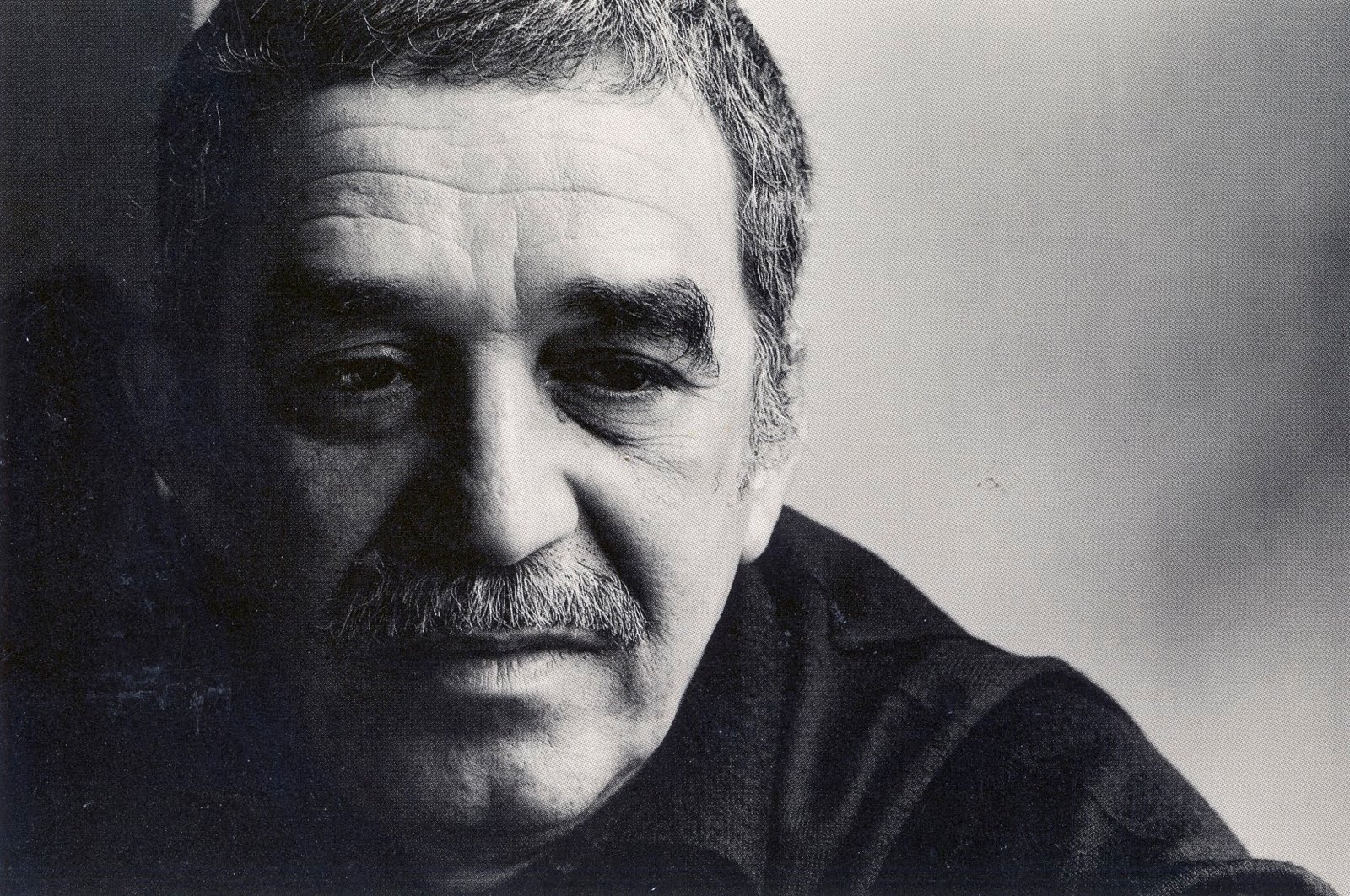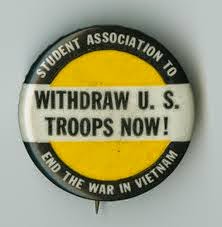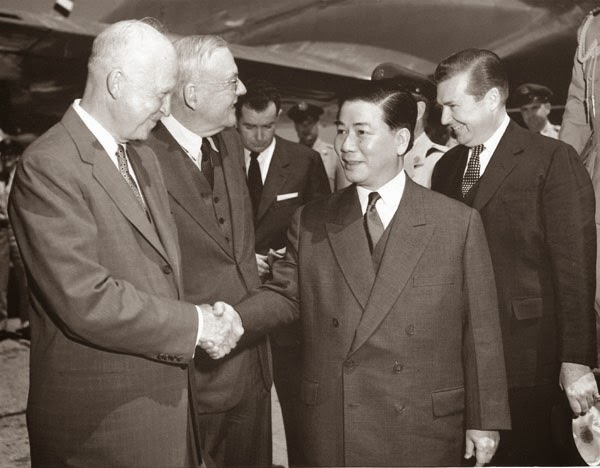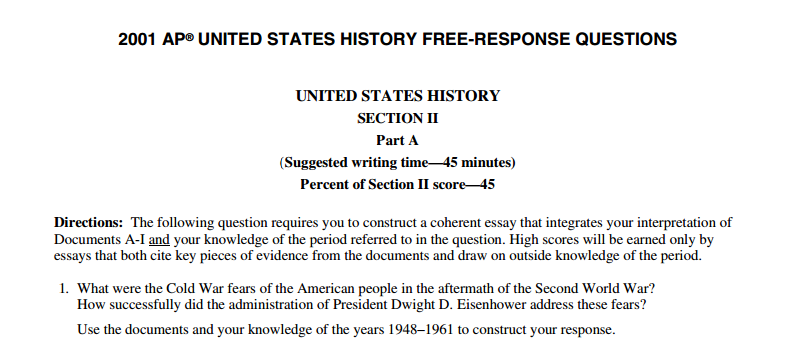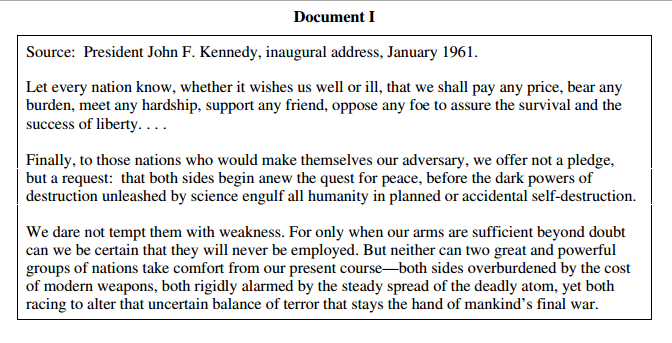The Cold War 1945-1963
The 8 - 9 Essay
Contains a well-developed thesis that identifies Cold War fears in the aftermath of World War II and evaluates how successfully the Eisenhower administration addressed these fears
Discusses several Cold War fears 1948ñ1961 and analyzes the degree of success of the Eisenhower administration in addressing these fears
Effectively uses a substantial number of documents
Supports thesis with substantial and relevant outside information
Is clearly organized and well-written
May contain minor errors
The 5 - 7 Essay
Contains a thesis that identifies Cold War fears 1948ñ1961 and actions taken by the Eisenhower administration
Discusses some Cold War fears 1948ñ1961 and some actions taken by the Eisenhower administration with regard to Cold War issues; may have limited analysis and may focus considerably more on one part of the question than the other
Uses some documents effectively
Supports thesis with some outside information
Shows evidence of acceptable organization and writing; language errors do not interfere with comprehension of the essay
May contain errors that do not seriously detract from the quality of the essay
The 2 - 4 Essay
Contains a limited, confused, and/or poorly developed thesis
Deals with the question in a general manner; simplistic explanation or answers only one part of the question
Quotes or briefly cites some documents
Contains little outside information or information that is generally inaccurate or irrelevant
Has problems in organization
May contain major errors
The 0 - 1 Essay
Contains no thesis or a thesis which does not address the question
Exhibits inadequate or inaccurate understanding of the question
Contains little or no understanding of the documents or ignores them completely
Is so poorly organized or written that it inhibits understanding
Contains numerous errors, both major and minor
The “-” Essay
- Completely off-topic or blank
DOCUMENT A: Source: Dwight Eisenhower, press conference, March 1954
Document Information:
Eisenhower says there is too much hysteria in the world.
We fear the Kremlin and what they will do to our friends around them.
We fear "unwise investigators" will go too far at home to combat internal problems.
We fear depression and job loss.
Inferences:
This suggests Cold War fears of the spread of communism.
Unwise "investigators" refers to Joseph McCarthy, HUAC, Loyalty Investigations.
It might remind students of US concerns about keeping the economy strong after WWII.
Economic instability could be a breeding ground for communism.
Eisenhower's use of the word "hysteria" might increase rather than defuse tensions.
Eisenhower's discussion of job loss hints at the recession 1953-1954.
DOCUMENT B: Source: John Foster Dulles, Secretary of State, June 1954
Document Information:
Dulles expresses concern about communism expanding in the Americas.
This expansion, he says, requires more sacrifices by the American people.
He argues that the situation in Guatemala has become so dangerous the American States had to do something.
The American States adopted a resolution declaring that the domination of an American state by communism would be a threat to all the American States.
Inferences:
Dulles is particularly concerned about Latin America because of its proximity.
It suggests the magnitude of Dulles fear of the spread of communism. (Domino theory)
It could be compared to Kennedy's response (Doc I) and to the problems that later developed with Castro in Cuba.
This could remind students that Dulles was also the supporter of brinkmanship & massive retaliation.
It may suggest connections to the Monroe Doctrine.
Students could discuss the difficulties the Eisenhower administration had in working with
Latin American nations to get this resolution passed and the undercurrent of anti-U.S. hostility at the conference.
Students might continue to discuss the actions the Eisenhower administration took in
Guatemala - CIA, support for the United Fruit Company
DOCUMENT C: Source: Life magazine, May 1955
Document Information:
A family is sitting in a bomb shelter (although that term is not used).
Canned food and canned water boxes sit to the side; a radio is also seen.
Bunks are provided for the family.
A few toys are scattered on the floor; the words ìKiddie Kokoonî are on the back wall under a
sleeping bag with handle.
Inferences:
This is a bomb shelter (hese were created by some people for themselves; air raid shelters
were also created in public places (schools, government buildings, etc.)
It suggests the magnitude of public and governmental fear; students could argue this program eased or increased public anxiety.
This suggests fears due to the fact that the Soviets had the atomic and then hydrogen bombs.
Other similar responses such as the Duck & Cover programs in schools and Civil Defense
programs could be discussed.
DOCUMENT D: Source: Saturday Evening Post, October 1956
Document Information:
The article announces that Eisenhower signed Public Law 627 on June 29.
It claims that this program of public works will ìdwarf any previous work of man.
The national system of Interstate and Defense Highways will, the author argues, get rid of the traffic congestion.
It will connect most of the cities having 50,000 or more people and serve the nationís main industrial and defense areas.
Inferences:
This suggests the huge impact made by the development of the interstate highway system such as allowing more people to own homes and made ìwhite flightî possible.
Students might discuss the defense purposes of the new program (getting troops and supplies to vital areas in case of attack, getting people away from cities in case of nuclear attack, having routes for planes to land & take off in emergencies).
It also suggests economic benefits from the highway program.
DOCUMENT E: Source: U.S. News and World Report, December 1957
Document Information:
The title reads MUST U.S. TAKE THE FIRST BLOW?î
The subtitle states The Problem of Massive Retaliation in the Missile Age.
It states that currently it is a 10 hour trip from Soviet bases to U.S. cities giving us time to alert our defenses and strike Soviet bases in massive retaliation.
It predicts that in the future Soviet missiles can arrive in 35 minutes leaving no time for defenses and limited power to retaliate.
It questions whether a policy of accepting the first blow is a good idea.
Inferences:
This suggests John Foster Dulles program of Massive Retaliation.
It also suggests increasing fears due to the development of missiles; missile gap debate.
Students might note that this represents a magazines agenda and not necessarily that of the government.
The Soviet development of missiles creates a need for new government policies (such as development of anti ballistic missiles, first strike capabilities, arms reduction.)
The impact of Sputnik could also be described (and ties made to Documents F and G).

DOCUMENT G: Source: Special Message to the Congress from President Eisenhower on
Education, January 1958
Document Information:
Eisenhower argues that the Federal government must play an "emergency role" in improving the educational system due to "national security" interests.
He argues that young people must be prepared to contribute the maximum to the country's future progress.
Eisenhower argues the country must pay special attention to science and engineering education because of the importance of science and technology.
Inferences:
This document suggests the impact that Sputnik had on American education.
It ties to the developing space race.
This is the National Defense Education Act.
This is a landmark education act providing direct federal assistance to public schools.
It also strengthened graduate education and the teaching of math and foreign languages.
The Advanced Placement Program was spawned by the same fears!
DOCUMENT H: Source: Historical Statistics of the United States, Statistical Abstract of the United
States, Department of Commerce.
Document Information:
This chart shows life expectancy at birth, GNP per capita in 1958 dollars, total government spending, surplus or deficit and defense spending for the years 1949-1959.
Life expectancy has risen steadily.
GNP generally rose but dipped in 1957.
Total government spending jumped dramatically in 1953, dropped in 1955, and then rose again.
There was a deficit in 1953, 1955 and a dramatic deficit in 1959; 1951 had the largest surplus.
Defense spending as a % of total spending was about 1/3 in 1949, peaked in 1953 at 68%, and was 58% by 1959.
Inferences:
The recession of 1957-1958 is reflected in the GNP figures.
The economy is growing but the deficit is increasing at the same time; defense spending possibly contributing to the deficit.
The 1956 highway act (Document D) may explain the jump in total government spending 1957+ (is it considered defense spending?).
The Korean War helps to explain the jump from 1949 (33%) to 1951 (51%) defense spending.
It helps to confirm Document F's argument that a huge amount of money is being spent on defense (missiles) but contradicts the cartoonist by showing a small decline in defense spending 1957-1959.
Students might tie the "New Look" Eisenhower program (emphasis on air and nuclear power) to these numbers.
Rise in defense spending could be tied to Eisenhower's warning about the military-industrial complex in his farewell address.
DOCUMENT I: President John F. Kennedy, inaugural address, January 1961
Document Information:
Kennedy warns other nations that we will pay any price, bear any burden to make liberty succeed.
He asks both sides to try to create peace so that the forces unleashed by science do not destroy humanity in a planned or accidental catastrophe.
He also says that we must negotiate from a position of strength
However, he warns that both sides are burdened by the cost of modern weapons, both are alarmed by the power of the deadly atom.
Kennedy also warns that both sides are racing to change that uncertain balance of terror that prevents mankind's final war.
Inferences:
The first part of the speech suggests that Kennedy will continue Cold War strategies despite the defense spending of the 1950's: Cold War Warrior.
The final paragraph suggests peaceful coexistence.
It ties to Document E in its concern about dealing with the dangers of the atomic age.
The defense spending statistics in Doc H tie to Kennedy's concern about the expense of modern weapons.
Sputnik and missile gap and the space race could also be discussed here.
Mutually Assured Destruction could also be mentioned
Fears of communists at home:
Joseph McCarthy
HUAC/Richard Nixon, Hollywood Ten, FBI/Hoover
Loyalty Program (Truman and Eisenhower)
Communist Party USA
Rosenbergs/ Alger Hiss/ Whitaker Chambers, pumpkin papers
The pink lady campaign (Nixon and Helen Gahagan Douglas senatorial campaign 1950)
Oppenheimer investigated by AEC and stripped of his security clearance for leftist associations
McCarran Act
Arthur Miller, Crucible
Censorship
Civil Rights movement (and the persecution of DuBois, Robeson, Bunche etc.)
John Birch Society
Invasion of the Body Snatchers, Them
Fears of the spread abroad
iron curtain
containment and George Kennan as its author
China goes communist (1949)
NSC-68 "Strive for Victory"
Korean War (1950-1953)
Soviet masterminding of global communist aggression: China, Korea, etc.
domino theory (Laos and Vietnam)
Vietnam and Dien Bien Phu and Diem in S. Vietnam
NATO
The Berlin Crisis
Nuclear weapons and the missile/space race
The Soviet Union has the A Bomb (1949)
H Bomb (1950)
Sputnik I and II
Flopniks and kaputniks (American failures)
Democratic charges of a "missile gap"
Soviets first test firing of ICBM in 1957 (1 month later Sputnik, then dog in space)
On the Beach
Economic concerns
EISENHOWER ADMINISTRATION RESPONSES
To fears of communists at home:
Eisenhower privately critical, did little openly to destroy McCarthy
Republicans used McCarthy in 1952 election
Eisenhower's Dartmouth speech 1953 "don't join the book burners"
McCarthy brought down by own flaws and Army-McCarthy hearings
Nixon, HUAC member, VP and strong anti Communist
Continued Loyalty programs
To fears of the spread abroad:
Eisenhower Doctrine (used in Jordan w/ attempted coup, not successful w/ Syria, Lebanon 14,000
troops then withdrew with UN Arab resolution) and shift focus from Europe to Middle East/
Latin America/Asia
Dulles ó Massive retaliation
The New Look A bigger bang for the buck
Brinkmanship
Domino theory (Laos, Vietnam)
Negotiated peace in Korea
supporter of NATO internationalist ñ defeated Bricker Amendment
Guatemala CIA covert aid to overthrow Colonel Arbenz-Guzman vs. United Fruit Company- CIA
trained mercenaries and American planes ñ Gen. Armas now dictator and United Fruit got its land back
CIA Operation Ajax recruited mob to help army topple Mossadegh in Iran and restore Shah to power (to protect oil)
Suez crisis- pressure France and Britain to withdraw
Inaction during the Hungarian crisis
Cuba ñ Castro vs. Batista ñ Ike authorizes Bay of Pigs plan by CIA
Formosa resolution ñ Ike requested of Congress power to protect Formosa (Taiwan) ñ stopped
Chinese assault 1954 and mutual defense treaty with Chinese Nationalists on Taiwan
Refusal to admit China to the UN or trade
Better relations w/ Khrushchev (1955+) ñ Geneva Summit Conference 1954 (Ike, Khrushchev,
Britain and France) spirit of Geneva though little of substanc Eisenhower's 'open skies'
proposal (rejected by SU)
Khrushchev visit 1959 warms relations (Camp David)
U-2 incident harms relations (1960)
SEATO CENTO
Concerned about our image abroad with civil rights movement
Voice of America/ Radio Free Europe; DEW line
To nuclear weapons and the missile/space race:
Ike moderate support for space race
Huge impact of Sputnik forced hand
Federal program to build bomb shelters/ Duck and Cover program for schools
US supplying missiles to Britain and NATO allies
NASA (1958) and Explorer I
MAD Mutually Assured Destruction
To economic concerns:
ESSAY
Buckets:
- communism spread abroad
- nuclear war
- depression
Thesis:
The end of the Second World War in 1945 resulted in a growing tension between the United States and the Soviet Union. Fortunately, President Eisenhower managed to soothe American hysteria, yet they continued to fear that communism would spread worldwide, cringed at the thought of nuclear war and grew anxious due to a potential depression.
Essay:
The end of the Second World War in 1945 resulted in a growing tension between the United States and the Soviet Union ultimately leading the Cold War which lasted until the late twentieth century. Fortunately, President Eisenhower managed to soothe American hysteria, yet the people continued to fear that communism would spread worldwide, cringed at the thought of nuclear war and grew anxious due to a potential depression.
Immediately after the end of the Second World War a fear that the influence of communism and the Soviet Union would spread throughout the world grew within Americans. Source B is a speech by Secretary of State, John Foster Dulles from June 1954. As Dulles expressed his personal concern about communism expanding in the Americas he suggested that the expansion needed more sacrifices by the American people. He additionally argued that the situation in Guatemala had become so dangerous that the United States had to do something. As a result, Americans introduced a resolution declaring that the domination of an American state by communism would be a threat to all the American States. From this source we can infer that Dulles is particularly concerned about Latin America because of its proximity and it expresses his fear of the spread of communism, subtly referring back to the Domino Theory,
The growing tension between the United States and the Soviet Union resulted in a suspicion that there would be a nuclear war. Due to the advancement in technology on behalf of both the Soviets and Americans, the tension proliferated rapidly. DOcument c is an image from May 1955 published in Life magazine. The image depicts a family sitting in a bomb shelter where canned food and water boxes are provided. There is even a radio and bunks. From this image we can draw the conclusion that bomb shelter were created by some people for themselves additional to the air raid shelters created in public places. The image suggests the magnitude of fear people had of nuclear war and fear that the Soviets had the atomic and hydrogen bombs. Document E is a U.S. News and World Report published in December 1957. Then it goes into detailing that the US had time to alert it’s defenses and strike Soviet bases in massive retaliation due to the 10 hour trip from Soviet bases to U.S. cities. It also predicts that in the future Soviet missiles would be able to arrive in 35 minutes and questions whether a policy of accepting the first blow is a good idea. Document G is a Special Message to the Congress from President Eisenhower on Education from January 1958. While Eisenhower argues that the Federal government must play an "emergency role" in improving the educational system due to "national security" interests he also suggests that young people must be prepared to contribute the maximum to the country's future progress. He even asserts that the country must pay special attention to science and engineering education because of the importance of science and technology.
A last and crucial fear among Americans after the end of World War II was the possibility of undergoing a depression. Document A Document A is press conference of Dwight Eisenhower which took place in March of 1954. Eisenhower suggests that there is too much hysteria in the world and he underscores the fear of Kremlin and what they will do to our friends around them, the "unwise investigators", depression and job loss. We can infer that Economic instability could be the supporting ground for communism. DOcument I is John F. Kennedy’s inaugural address which he delivered in January 1961 and in which he warns other nations that we will pay any price, bear any burden to make liberty succeed. Kennedy even asks both sides to try to create peace so that the forces unleashed by science do not destroy humanity in a planned or accidental catastrophe and that Americans must negotiate from a position of strength; however, he warns that both sides are burdened by the cost of modern weapons and alarmed by the power of the deadly atom.
The time after the second World War II was a time of hysteria, fear, and anxiousness for the United States and it’s people. Due to the growing tension between the United States and the Soviet Union, the advancement in technology, and all the risks that were being taken, AMericans focused on three main fears. THey included the fear of the spread of communism abroad, the fear of nuclear war and of course, the fear of depression.

